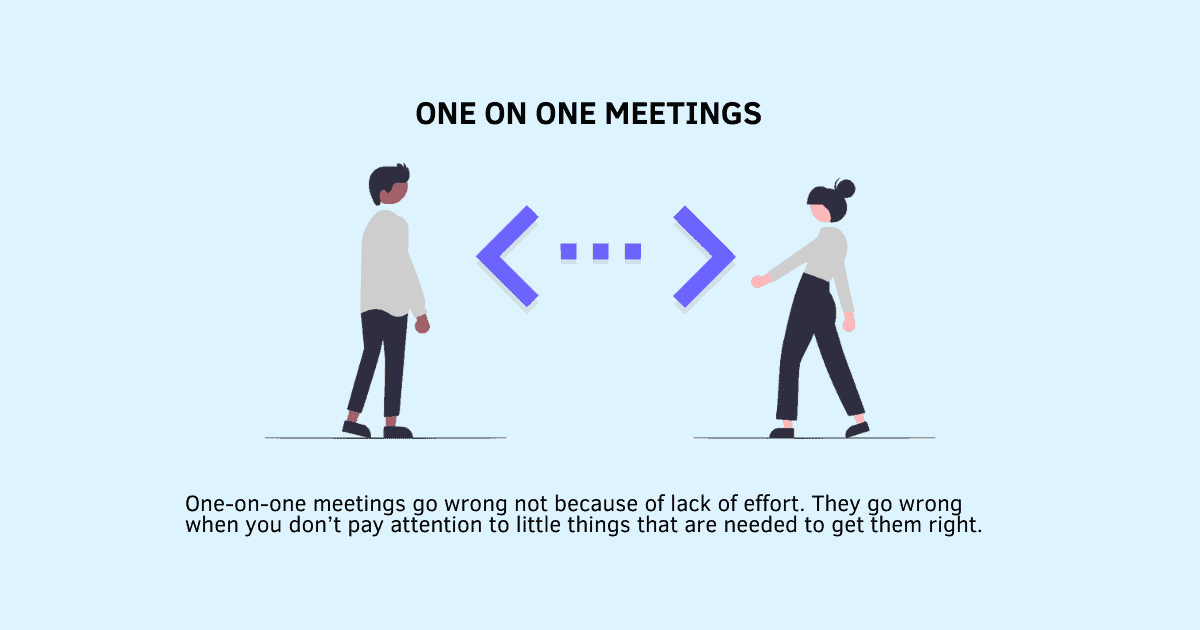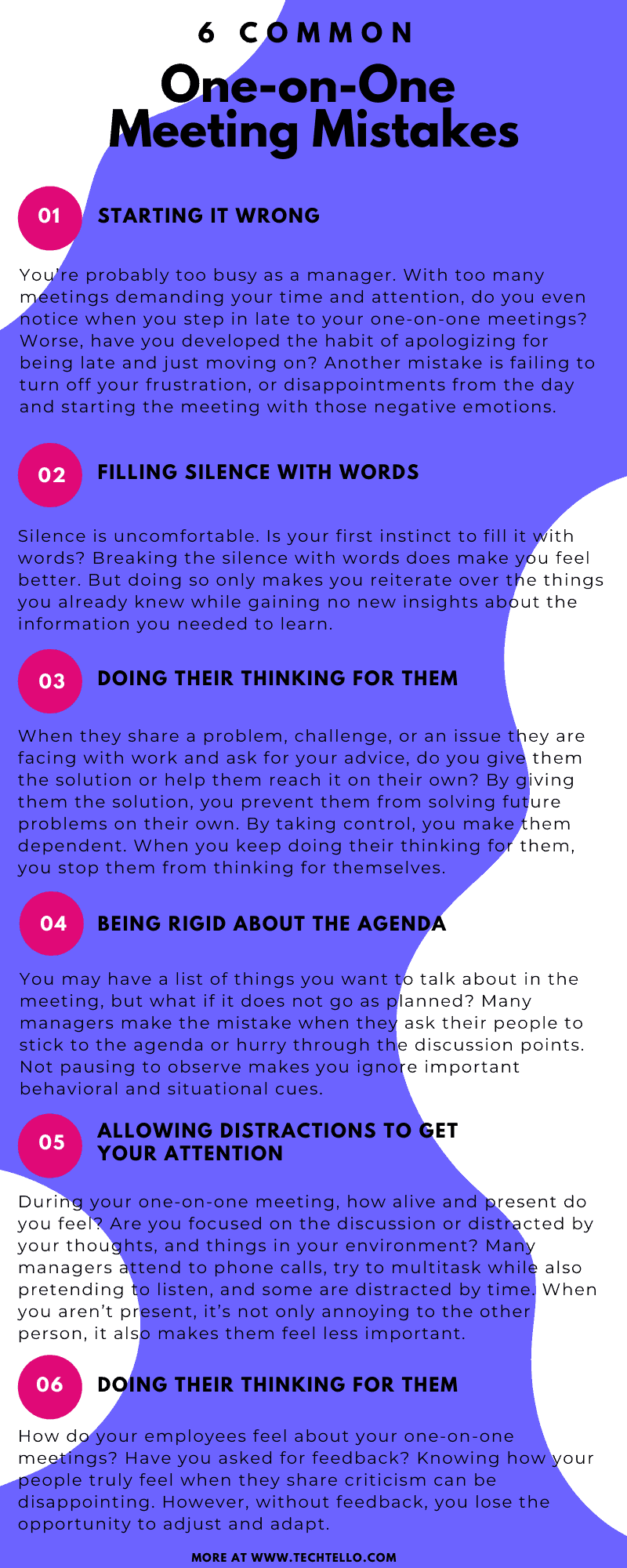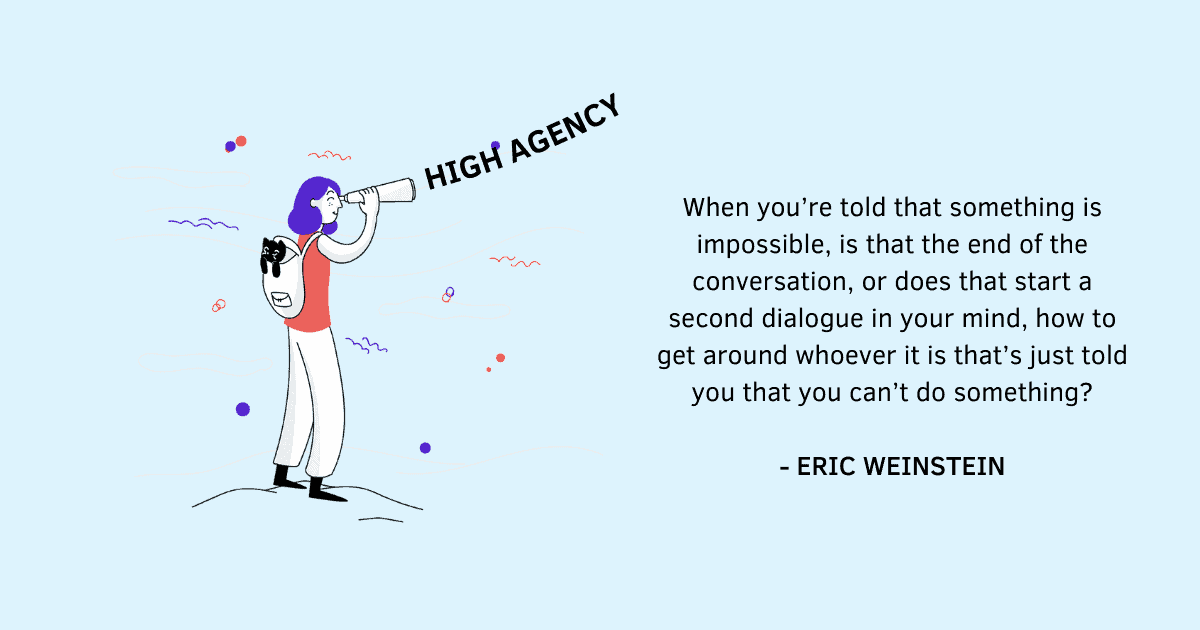These One-on-One Meeting Mistakes are Hurting Your Team

Do you regularly meet your people, give them advice and help them with their growth? You might be doing a lot of things right, but do you also take time to analyze the mistakes that can turn your one-on-one meetings unproductive and leave your people feeling dissatisfied?
I know from experience that we pay a lot of attention to perfecting what’s visible (agendas, feedback, strategy, problems), while often ignoring or paying little to no attention to the invisible parts (your body language, attitude, behavior) that can turn a perfectly good one-on-one meeting into a bad experience and leave people feeling judged, ignored and annoyed.
Frequently speaking to your people is a great way to stay connected, address their concerns and identify problems that demand your attention. But simply spending time or completing an agenda is no measure of the value you bring to your team. You may have a one-on-one meeting every week. But what’s the point when your people treat it as an obligation as opposed to considering it the best use of their time.
One-on-one meetings go wrong not because of lack of effort. They go wrong when you don’t pay attention to little things that are needed to get them right.
Instead of saying that you’re doing the best you can or assuming that you’re doing everything right, watch out for these common mistakes. You may not be doing them intentionally. But doing them unconsciously is not an excuse either. Once you start paying attention to these mistakes, the quality of your one-on-one meetings will not only improve, it will leave you and your people better connected and feeling more satisfied.
6 common mistakes during one-on-one meetings
1. Starting it wrong
You’re probably too busy as a manager. With too many meetings demanding your time and attention, do you even notice when you step in late to your one-on-one meetings? Worse, have you developed the habit of apologizing for being late and just moving on?
Let’s face it. Not all those meetings are worth your time. Doing your one-on-one right is going to be the biggest return on investment of your time.
For you it may be just one of many conversations, but not for them. When you don’t come to a one-on-one meeting on time, it conveys that it holds less importance in your mind.
Another mistake is failing to turn off your frustration, or disappointments from the day and starting the meeting with those negative emotions. When you don’t consciously shift your frame of mind, you’re stuck with old thoughts and quite likely to begin by complaining about your troubles. It may be comforting to state your problems out loud, but starting with you and your problems shifts the focus of the discussion even before it has started. It makes it about you and not them.
Correct this one-on-one meeting mistake:
Two things you need to do while starting to set a positive tone for the rest of the conversation:
- Make it to the meeting on time.
- Consciously plan how you’ll begin the conversation.
If you aren’t sure about what to say in the beginning, here are a few topics to get started:
- Ask about how their day has been so far. What’s been the highlight of the day or biggest challenge they faced today.
- Talk to them about a problem they brought up in the last discussion. How has it been for them now? What all did they try? What worked? What didn’t?
- If there’s been an important announcement or a change that impacts them, tell them about it and address their concerns.
- Ask what’s been at the top of their mind since you last met.
- You can even start by recapping the notes from the last meeting and sharing updates on your action items.
It’s important to start the meeting right. You can’t do that unless you plan what you intend to say in the beginning and start the meeting on time.
2. Filling silence with words
Silence is uncomfortable. Is your first instinct to fill it with words? Does the voice in your head shout “say something…just anything.”
Sitting in silence isn’t easy. Filling it with more questions, and more information that’s sometimes even irrelevant to the context isn’t helpful. It takes away the space needed to encourage the other person to think and speak.
Breaking the silence with words does make you feel better. But doing so only makes you reiterate over the things you already knew while gaining no new insights about the information you needed to learn.
Correct this one-on-one meeting mistake:
Robert Sutton writes in Good Boss, Bad Boss “Listen to those under your supervision. Really listen. Don’t act as if you’re listening and let it go in one ear and out the other. Faking it is worse than not doing it at all.”
To keep the conversation effective, embrace silence. Do more listening and less talking. Ask questions. More and more questions. Show curiosity to know them better – how they think, what they care about, what troubles them?
Sometimes silence may lead to more silence and they may say nothing. In this case, encourage them to speak up in one-on-one meetings by saying these things:
- Take your time. I want to hear your opinion.
- What do you have to say about this?
- I want to hear more from you.
- It’s fine if you aren’t ready. We can meet again and discuss it.
It’s important to make them feel comfortable to open up. You can’t do that if you do most of the talking.
3. Doing their thinking for them
When they share a problem, challenge, or an issue they are facing with work and ask for your advice, do you give them the solution or help them reach it on their own?
There’s a possibility you have solved the problem before. You may even know the answer before they have completed the question. After all, you’ve been in their position and seen it all.
It does feel exciting to solve another person’s problem. Makes you feel important and validates you’re worthy of your position. But irrespective of how much you’re tempted to give them the solution, don’t.
Don’t do their thinking for them. Don’t take the problem away by saying that you will take care of it especially if it involves conflict with another person or team. There’s a difference between giving direction and taking control.
By giving them the solution, you prevent them from solving future problems on their own. By taking control, you make them dependent. When you keep doing their thinking for them, you stop them from thinking for themselves. Being involved in every small problem and every small decision may give you a feeling of control, but it also prevents your team from growing.
Correct this one-on-one meeting mistake:
Kim Scott writes in Radical Candor “A boss’s ability to achieve results had a lot more to do with listening and seeking to understand than it did with telling people what to do; more to do with debating than directing; more to do with pushing people to decide than with being the decider; more to do with persuading than with giving orders; more to do with learning than with knowing.”
To help your team navigate the challenges and dynamics of a work environment, enable them to build creative thinking skills. Coach them to build the knowledge and the skills required to make decisions on their own.
When they struggle with a problem, ask for their understanding of the problem and help them find a solution by asking these questions:
- How big do they think the problem is?
- Why do they think it’s important to be solved?
- What solutions have they tried to fix the problem?
- What next steps can they take?
- What kind of help have they sought from others?
- What’s the worst that can happen if it continues to exist?
By helping your team members develop the perspective it takes to solve problems and make decisions on their own, you shift them from feeling powerless and helpless to feeling in control.
4. Being rigid about the agenda
You may have a list of things you want to talk about in the meeting, but what if it does not go as planned? What if they want to talk about something that was not on agenda? What if they want to spend more time on a specific topic leaving less time for other items on the agenda?
Many managers make the mistake when they ask their people to stick to the agenda or hurry through the discussion points. Not pausing to observe makes you ignore important behavioral and situational cues. You may fail to evaluate what the situation demands. Your one-on-one meeting shouldn’t be just about the agenda. It’s ineffective if you’re inflexible to adapt or miss the parts that demand your attention.
Correct this one-on-one meeting mistake:
Slow down the conversation. You can start with an agenda, but let the flow of the conversation guide how it goes. If a topic needs a longer discussion, don’t rush through it. If they have something at the top of their mind that they want to be addressed first, do so.
To make sure, you aren’t moving too fast or ignoring the parts that require your attention, ask these questions:
- Do you have something important that you want to discuss first?
- Did I miss something on this topic that we need to discuss?
- Are we clear on the next steps or does this need further discussion?
Knowing the agenda helps in having a productive conversation. However, being rigid about it can limit and constrain the discussion.
5. Allowing distractions to get your attention
During your one-on-one meeting, how alive and present do you feel? Are you focused on the discussion or distracted by your thoughts, and things in your environment?
Many managers I have seen attend to phone calls during 1-1s, try to multitask by typing an email while also pretending to listen, and some are distracted by time. They probably have something to get to and keep checking for time.
When you aren’t present, it’s not only annoying to the other person, it also makes them feel less important. Why would they tell you the real problems when you care more about your distractions and less about their problems? Why would they trust you to help them grow when you can’t even focus on the discussion? The more distracted you seem, the more it convinces them to shut up and stop wasting their time.
Correct this one-on-one meeting mistake:
David Rock says in Your Brain At Work “Maintaining a good focus on a thought occurs through not so much how you focus, but rather how you inhibit the wrong things from coming into focus.” In other words, identify what distracts you and consciously get rid of that distraction.
If your people aren’t speaking up in one-on-one meetings or if you’re having a hard time earning their trust, pay attention to your thoughts and body language:
- Are you distracted by your thoughts? Do you often engage in mind wandering?
- Do you have a tendency to check your laptop, phone, or watch?
- Do you avoid eye contact?
- How’s your body language? Does it show you’re paying attention towards them or away from them?
Being present physically and mentally requires conscious effort. Getting rid of your distractions enables you to not only listen to their words but also be watchful of their body language. When you’re engaged in the discussion, it builds trust and makes them feel comfortable to have an honest conversation.
6. Ignoring the feedback loop
How do your employees feel about your one-on-one meetings? Have you asked for feedback? Do you have real data?
Knowing how your people truly feel when they share criticism can be disappointing. However, not having a sense of how you’re doing is even worse. Without feedback, you lose the opportunity to adjust and adapt. Without knowing what parts they find useful and which ones to avoid, you end up forcing a conversation without making an effort to have a productive discussion.
Making assumptions or going with your gut feeling can often mislead. It’s impossible to know what goes on in someone else’s head. It’s also not possible for you to completely analyze the impact of your behavior on others. You can’t feel their emotions. You can’t see what they see.
Correct this one-on-one meeting mistake:
Elon Musk says “It’s very important to have a feedback loop, where you’re constantly thinking about what you’ve done and how you could be doing it better.”
The only way to make your one-on-one meetings better is to get past your discomfort, seek feedback, identify the changes that will make them look forward to these discussions, and then go ahead and implement them step at a time.
To get feedback on your one-on-one meetings, ask these questions. They may not speak up the first time around. Give them time. Encourage them to be honest. Show them that they can trust you:
- Which parts in our one-on-one meeting do you find useful?
- What do you think is a waste of time?
- On a scale of 1-5, how effective do you find these discussions?
- What can we do better together?
- What will make these meetings the best use of your time?
- What one change can make you feel excited about our discussion?
Summary
- One-on-one meetings may not go wrong because of lack of effort. They become unproductive when you don’t pay attention to the little mistakes that must be avoided to get them right.
- The beginning of a meeting is as important as its end. Show respect by starting the meeting on time and shift your frame of mind to open the dialogue with useful information or by asking a powerful question.
- Shut up and embrace silence. You can’t keep speaking and expect them to share useful information.
- Guide them and coach them into thinking for themselves. Don’t do their thinking for them.
- Your meeting should have an agenda, but that shouldn’t make you inflexible to adjust and adapt. Watch out for cues and pay attention. Zoom in and zoom out as needed.
- Be present and pay attention instead of being distracted by your thoughts or the things in your environment. You can’t be distracted and have a productive conversation at the same time.
- Instead of making an assumption about how you’re doing, ask for feedback. Seeking feedback and incorporating it in your one-on-one meetings will build trust and make them look forward to these discussions.






























